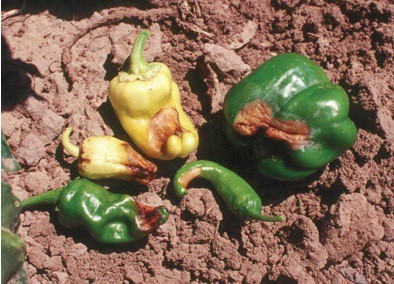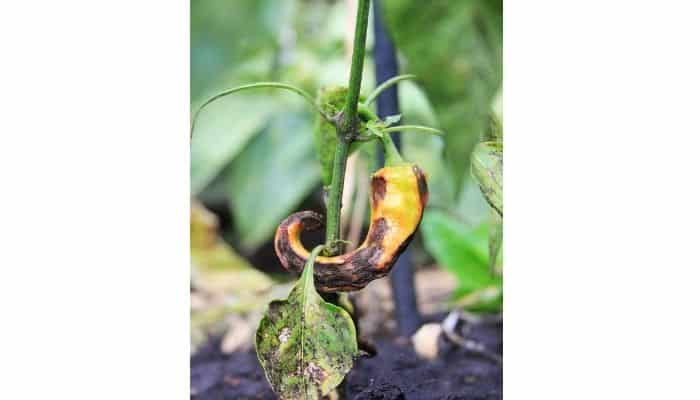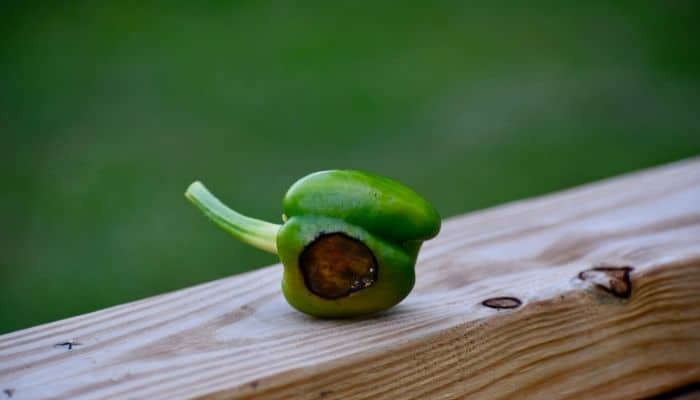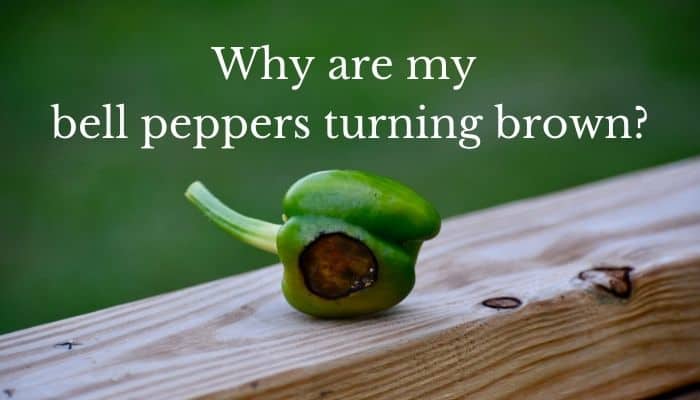Brown spots on bell peppers appear when the plant is affected by Blossom End Rot. Brown spots on bell peppers could also be caused due to Anthracnose or Sunscalding.
Bell peppers are amazing vegetables. They add not only nutrients but also color to your food. Growing them can be really difficult as they are prone to various fungal diseases.
Blossom End Rot signs
It is often confused with Sun scalding. Blossom end rot can be identified by brown circular lesions at the bottom of bell pepper fruits. It begins as light green/yellowish spots.
Large BER spots may eventually harbor fungus. Blossom end rot can be attributed to many factors that I listed below.
Here are the common causes of Blossom End Rot.
- Lack of Calcium in the soil is the most common reason. The skin of the bell peppers needs calcium to form and if there’s no calcium the skin is degraded into little soft brown spots.
- Inconsistent watering can cause this. Try to water them just enough but consistently.
- Can overwatering cause blossom end rot? Yes. They just need 2-4 inches of water weekly. Make a schedule to provide water to your plants consistently and adequately.
- Excess use of fertilizers. Using a lot of fertilizer in the hopes of getting a better yield will actually ruin your bell peppers. Nitrogen and Potassium can hinder the absorption of Calcium by plants. Excess Sodium and Ammonium also cause this disorder.

How do you treat brown spots on Peppers?
Sadly the fruits that are already affected can’t be revived. You just need to make your conditions better for the next season. Let’s see how you can do that.
Amending the soil
The best way to amend the soil is by adding eggshells to the affected soil(long-term fix). You can also add bone meal to make your soil habitat better.
Other fixes:
- Epsom salt can do wonders for your affected soil. Add a tablespoon of it to every gallon of water you supply to your plants. Do this once before you plant your peppers.
- Side-dressing your plants can prove quite helpful in keeping them healthy. You can use fertilizers like Espoma-Tomato tone, it might say tomato but it works well on bell peppers too.
- Water your bell peppers regularly and adequately. Bell peppers need 2-4 inches of water a week. Spread out your watering sessions over the week, you don’t want to overwater/water them inconsistently. Water helps better absorption of calcium by the plant.
- Put a good layer of mulch, this helps the soil retain moisture, especially during the summer.
- Use nitrate-nitrogen as fertilizer instead of ammoniate nitrogen.
- Restricted root growth may also lead to BER as it reduces water intake by the plant thus depriving the plant of the essential Calcium.
How often should I water pepper plants?
As I said earlier, you may water it every other day, but make sure to give your plants 2-4 inches of water weekly. It’s even better if you use soaker hoses for garden irrigation, as it prevents leaf damage.
Brown spots inside bell pepper, safe to eat?
Yes, you can eat peppers with blossom end rot. Just cut the affected part and you can use it in any of your recipes. It’s not a disease, it’s just a disorder caused by lack of calcium.
Let’s look at other types of brown spots now.
Sun scalding on peppers
Developing bell pepper fruits have delicate skin and many varieties of bell peppers get tanned due to high temperatures and fiery sun. Heat damages the skin and the sun worsens the already affected part.
Sun scalding usually starts as white/dark lesions on delicate parts of the plant. This damage may worsen due to bacteria and fungus.

This can be differentiated from blossom end rot as sun scalding not only occurs on fruits but also on leaves and stems. These spots may appear anywhere on the fruit, unlike blossom end rot which appears only at the end.
How to fix Sun Scalding?
Replace the plant with a variety that has vigorous foliage and the leaves will take care of excess heat and sunlight. You may also want to use a straw/screen to keep your fruits in the shade.
Take good care of your leaves, wilted/diseased leaves aren’t able to shield fruits from the sun. Plant your bell peppers in such a place so that they get just enough sunlight.
You can use shade cloth that provides shade to the entire plant during the brighter hours of the day.
Anthracnose on Bell Peppers
It is caused by a common fungal pathogen. It causes brown, circular lesions on almost all parts of the plant, but if the fruits are affected, it will be a great financial loss.
On fruits, it appears on the sides. Initially, the spots look like water-soaked lesions and they slowly turn brown/black.
You should remove the infected plant and all its debris from the garden as it can affect the surrounding plants. It is seen in other types of peppers too.

When you are planting another batch of peppers make sure they are free of any fungal infections. This infection can be transferred through seeds.
There are no resistant varieties in bell pepper. But you can avoid Anthracnose by planting those varieties which have a shorter ripening period.
You may want to keep insects and other pests in check, as wounds will increase the risk of Anthracnose infection. Some fungicides can be used to successfully control the infection.
Can you eat peppers with Sun scald/Anthracnose?
Yes, you can. Just cut off the part that’s affected and you’re good to go. If the fruits are infected by fungal/bacterial growth entirely, it’s better to dispose of them.
Wrappin’ it up,
The best fix for such diseases/disorders is to prevent them. You have to select resistant varieties whenever possible, choose those varieties with extensive foliage cover that shade the fruits.
Fertilize your peppers adequately and just before the flowering season as they need nutrients for the formation of fruits and healthy foliage.
Water your plants regularly and do not “shock” your plants by suddenly exposing them directly to sun. Plant them at a place where they get just enough sunlight.
I wish you a colorful bell pepper garden!

